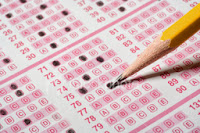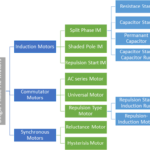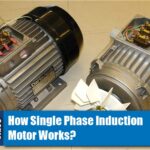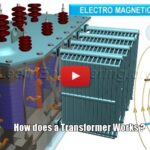2. A capacitor start, capacitor run single phase induction motor is basically a
(A) ac series motor
(B) dc series motor
(C) 2 phase induction motor
(D) 3 phase induction motor.
3. The starting torque of a capacitor start motor is
(A) zero
(B) low
(C) same as rated torque
(D) more than rated torque.
4. The torque developed by a split phase motor is proportional to
(A) Sine of angle between lm and ls
(B) Cosine of angle between lm and Is
(C) Main winding current, Im
(D) Auxiliary winding current,Is
5. A capacitor start single phase induction motor is switched on the supply with its capacitor replaced by an inductor of equivalent reactance value. It will
(A) not start
(B) start and run
(C) start and then stall
(D) none of the above.
6. The starting capacitor of a single phase motor is
(A) Electrolytic capacitor
(B) Ceramic capacitor
(C) Paper capacitor
(D) None of the above.
7. Which of the following is the most economical method of starting a single phase motor ?
(A) Resistance start method
(B) Inductance start method
(C) Capacitance start method
(D) Split-phase method.
8. The number of turns in the starting winding of a capacitor start motor as compared to that for split phase motor is
(A) same
(B) more
(C) less
(D) none of the above.
9. In a split phase motor, the ratio of number of turns for starting winding to that for running winding is
(A) 2.0
(B) more than 1
(C) 1.0
(D) less than 1.
10. A single phase motor generally used for small air compressor is
(A) capacitor start capacitor run motor
(B) reluctance motor
(C) universal motor
(D) shaded pole motor.
11. Out of the following motors, which will give the highest starting torque ?
(A) Universal motor
(B) Capacitor start motor
(C) Shaded pole motor
(D) All have zero starting torque.
12. Which single phase ac motor will you select for record players and tape recorders ?
(A) Hysteresis motor
(B) Shaded pole motor
(C) Reluctance motor
(D) Two value capacitor motor.
13. A universal motor is one
(A) which can run on any value of supply voltage
(B) which has infinitely varying speed
(C) which can operate on ac as well as dc voltage
(D) which can work as single phase or three phase motor.
14. Under normal operating conditions which motor can run at 5000 rpm ?
(A) Synchronous motor
(B) Induction motor
(C) Universal motor
(D) No motor can give 5000 rpm.
15. The motor used in household refrigerators is
(A) dc series motor
(B) dc shunt motor
(C) universal motor
(D) single phase induction motor.






Comments are closed.